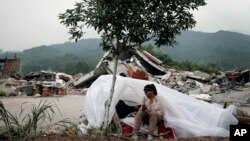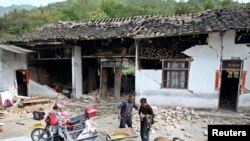BEIJING —
As relief efforts are underway in earthquake-stricken parts of southwest China, the public rushes to donate money and some ask what lessons the government learned from the Wenchuan quake that jolted nearby areas five years ago.
On Tuesday, three days after the magnitude 7 earthquake hit Ya'an city, firefighters were still digging at homes in Lushan and Baoxing county, two of the worst hit zones.
Military helicopters continued to drop aid packages to some of the more isolated areas, where roads leading into the villages are damaged and there is still a high risk of falling rocks and landslides.
In 2008, a few days after a magnitude 8 earthquake hit Wenchuan, about 190 kilometers southwest of the epicenter of Saturday's earthquake, Emily Chan, director of the Disaster and Medical Humanitarian Response center at the Chinese University of Hong Kong, was on the scene helping out with the rescue response.
Chan said that compared to five years ago, authorities were faster to respond this time.
“If we look at the rescue part of this earthquake operation, I think it has been done in a very reasonable way,” Chan said. “The fact that the government managed to send teams that arrived on site two hours post earthquake, it shows and demonstrates an efficient immediate response.”
But Chan said the real challenge will start when the rescue phase ends, and the relief and reconstruction begins.
Infrastructure
“There are a number of sites where there are a lot of casualties, and a lot of needs, which start to become more apparent after the rescue phase is completed and people start to need the medical support and post-disaster services,” she said.
Chan said China upgraded some of its earthquake building standards after the Wenchuan earthquake left almost 90,000 people dead and highlighted the problem of insecure buildings, particularly schools and hospitals.
But in an article in the China Youth Daily on Tuesday titled “On anti seismic constructions, we have to learn from Japan,” commentator Guo Wenjing noted that in some counties of Ya'an most buildings were damaged by the earthquake, including homes rebuilt after the Wenchuan earthquake.
“In Japan, for a standard eight-to-nine-story building, there are easily two to three hundred pages only devoted to anti seismic inspections,” the article said, “but for Chinese skyscrapers the entire building permits and documents might not even reach two to three hundred pages.”
Rescue efforts in Ya'an have been particularly hard because the affected area includes rural villages surrounded by hills, with often only one mountainous road to connect them with more developed urban centers.
Technicalities
Tian Feng, a civil society coordinator based in Chengdu, has been following the government and civil society response. He said even though the government has been faster in providing relief and more transparent in giving out information to the public, compared to 2008, some technical issues remain.
Tian said that near Longmen mountain, where the quake hit, there are some roads that are wide enough for trucks carrying weight to pass, but some areas where that is not advised.
“In some parts there is only a narrow canyon, and that is where traffic jams occurred very early on [in the emergency response], there was no way to get information and rescue staff in,” Tian said.
He said similar problems had occurred in 2008, and sending more helicopters to isolated areas earlier might have helped.
In the early hours after the quake, hundreds of volunteers rushed to the region, in what Tian called a “warm, but perhaps too fast” response to the tragedy.
Authorities are now telling volunteers not to enter the area, and to help keep local transportation and relief work unobstructed.
“From 2008 Wenchuan earthquake we had already learned that in the first phase of rescue work, civil society organizations are not very effective,” Tian said. He adds that local NGOs will play a more important role later, when their expertise on local conditions will be crucial to help victims and rebuild the area.
Public response
People have been making donations to charity organizations working for earthquake relief, and called for more online transparency over the funds' allocation.
Many Chinese have preferred to give their money to smaller, private NGOs instead of larger state-run groups, like the Red Cross which in recent years had been tainted by some corruption scandals.
On Weibo, China's Twitter-like service, many posted survival tips and advice on how to help others in an earthquake.
Chinese University of Hong Kong's Chan said more government action is needed to help educate the public about quake survival and response.
Although the government has stressed the need to help oneself until other help arrives, many living in remote areas are the elderly and the young who, analysts said, are less equipped to face emergency and find shelter.
On Tuesday, three days after the magnitude 7 earthquake hit Ya'an city, firefighters were still digging at homes in Lushan and Baoxing county, two of the worst hit zones.
Military helicopters continued to drop aid packages to some of the more isolated areas, where roads leading into the villages are damaged and there is still a high risk of falling rocks and landslides.
In 2008, a few days after a magnitude 8 earthquake hit Wenchuan, about 190 kilometers southwest of the epicenter of Saturday's earthquake, Emily Chan, director of the Disaster and Medical Humanitarian Response center at the Chinese University of Hong Kong, was on the scene helping out with the rescue response.
Chan said that compared to five years ago, authorities were faster to respond this time.
“If we look at the rescue part of this earthquake operation, I think it has been done in a very reasonable way,” Chan said. “The fact that the government managed to send teams that arrived on site two hours post earthquake, it shows and demonstrates an efficient immediate response.”
But Chan said the real challenge will start when the rescue phase ends, and the relief and reconstruction begins.
Infrastructure
“There are a number of sites where there are a lot of casualties, and a lot of needs, which start to become more apparent after the rescue phase is completed and people start to need the medical support and post-disaster services,” she said.
Chan said China upgraded some of its earthquake building standards after the Wenchuan earthquake left almost 90,000 people dead and highlighted the problem of insecure buildings, particularly schools and hospitals.
But in an article in the China Youth Daily on Tuesday titled “On anti seismic constructions, we have to learn from Japan,” commentator Guo Wenjing noted that in some counties of Ya'an most buildings were damaged by the earthquake, including homes rebuilt after the Wenchuan earthquake.
“In Japan, for a standard eight-to-nine-story building, there are easily two to three hundred pages only devoted to anti seismic inspections,” the article said, “but for Chinese skyscrapers the entire building permits and documents might not even reach two to three hundred pages.”
Rescue efforts in Ya'an have been particularly hard because the affected area includes rural villages surrounded by hills, with often only one mountainous road to connect them with more developed urban centers.
Technicalities
Tian Feng, a civil society coordinator based in Chengdu, has been following the government and civil society response. He said even though the government has been faster in providing relief and more transparent in giving out information to the public, compared to 2008, some technical issues remain.
Tian said that near Longmen mountain, where the quake hit, there are some roads that are wide enough for trucks carrying weight to pass, but some areas where that is not advised.
“In some parts there is only a narrow canyon, and that is where traffic jams occurred very early on [in the emergency response], there was no way to get information and rescue staff in,” Tian said.
He said similar problems had occurred in 2008, and sending more helicopters to isolated areas earlier might have helped.
In the early hours after the quake, hundreds of volunteers rushed to the region, in what Tian called a “warm, but perhaps too fast” response to the tragedy.
Authorities are now telling volunteers not to enter the area, and to help keep local transportation and relief work unobstructed.
“From 2008 Wenchuan earthquake we had already learned that in the first phase of rescue work, civil society organizations are not very effective,” Tian said. He adds that local NGOs will play a more important role later, when their expertise on local conditions will be crucial to help victims and rebuild the area.
Public response
People have been making donations to charity organizations working for earthquake relief, and called for more online transparency over the funds' allocation.
Many Chinese have preferred to give their money to smaller, private NGOs instead of larger state-run groups, like the Red Cross which in recent years had been tainted by some corruption scandals.
On Weibo, China's Twitter-like service, many posted survival tips and advice on how to help others in an earthquake.
Chinese University of Hong Kong's Chan said more government action is needed to help educate the public about quake survival and response.
Although the government has stressed the need to help oneself until other help arrives, many living in remote areas are the elderly and the young who, analysts said, are less equipped to face emergency and find shelter.










